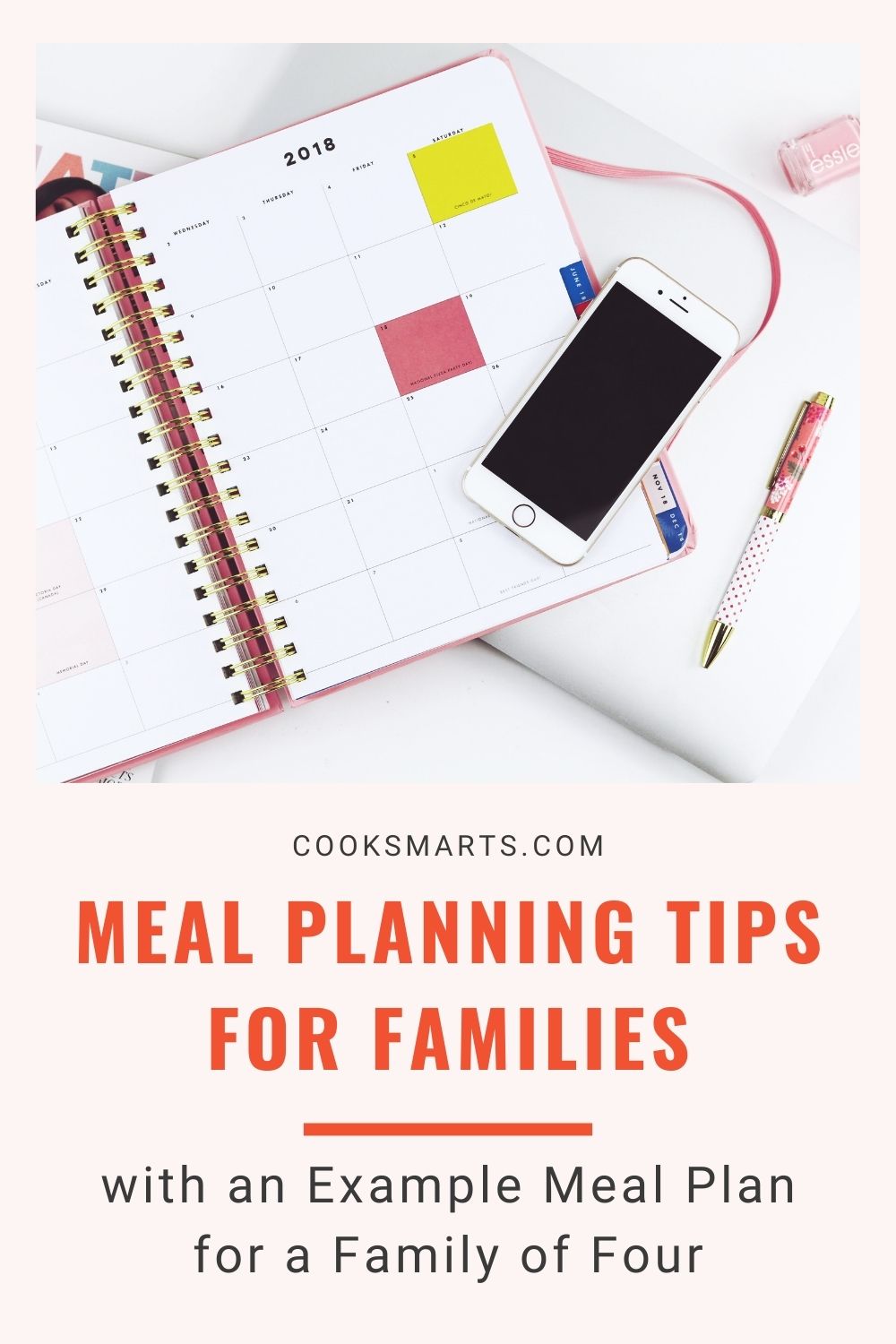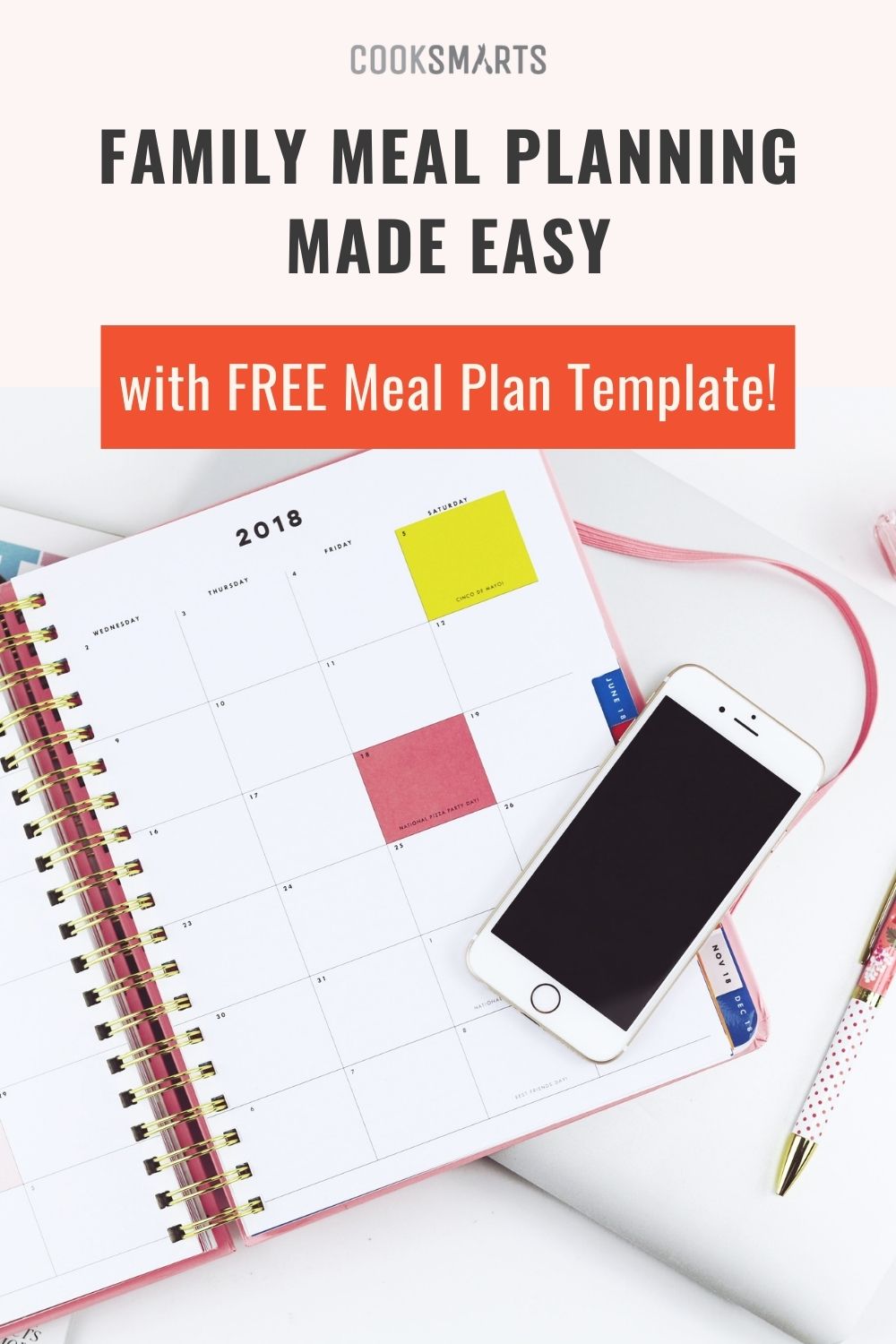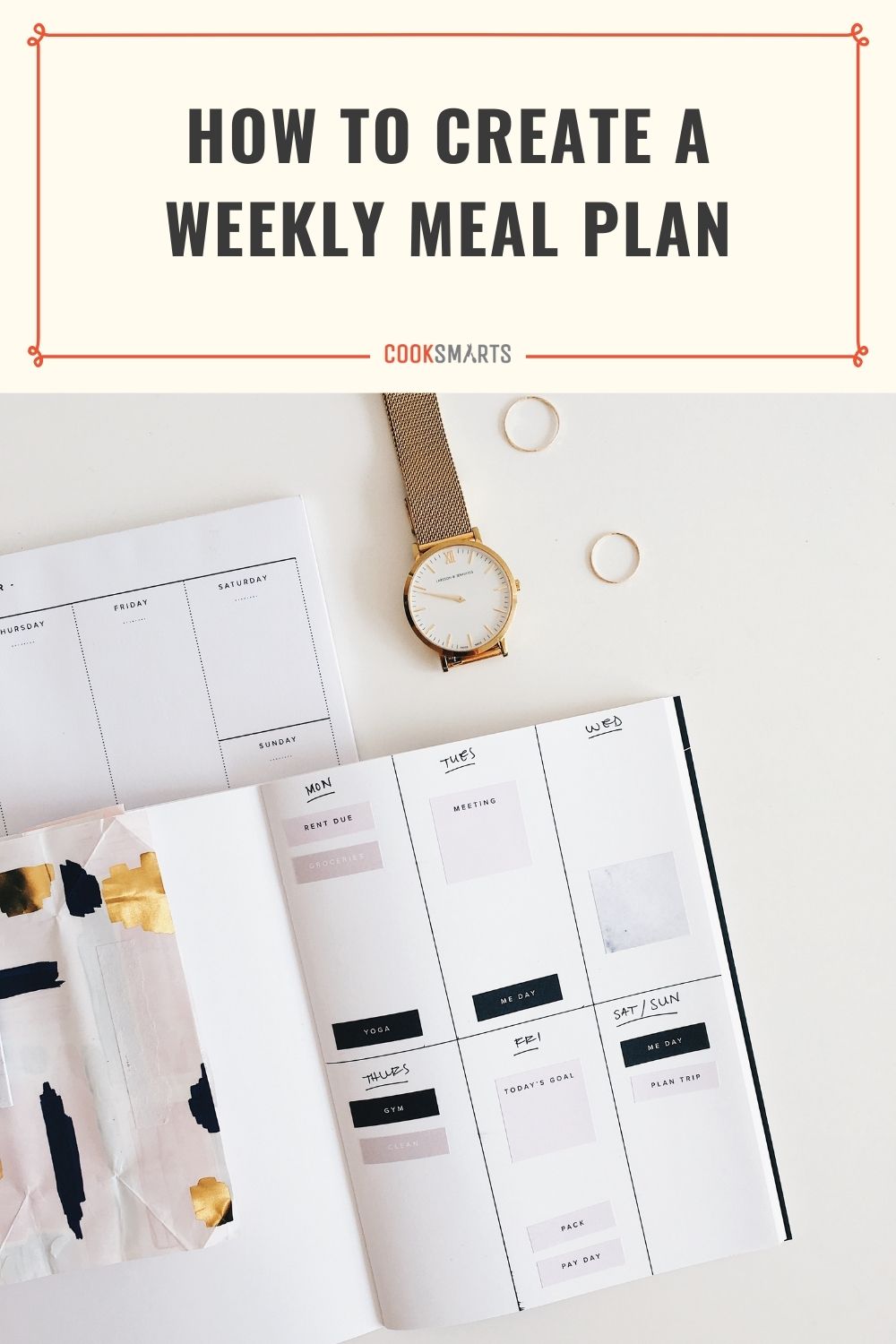Meal Plan Example: Learn the Basics of Meal Planning for a Family of 4
Follow along as we create a meal plan for a week! This meal plan for a family of 4 can be used as a meal planning template, or simply a meal plan example to help you see how to make meal planning work in real-world situations.
Learning to meal plan for a week is a fantastic skill that will serve you for the rest of your life. Meal planning helps people waste less food, save money, eat healthier, and stress less during the week. But reading tips for meal planning is one thing — actually creating a plan from scratch every week is another entirely.
That’s why we thought it would be so useful to share a meal plan example where we take you through step by step and demonstrate how to create a meal plan. This meal plan for a family of 4 is fairly simple, but does take into account some of the variation and complexity that families have to plan for each week. Our hope is that by showing a realistic meal plan (no, our plan doesn’t include cooking 7 nights a week!), we’ll inspire you to see that meal planning doesn’t have to be hard — and your plan doesn’t have to fall apart if anything unexpected happens.
If creating a meal plan feels overwhelming or anxiety-inducing, you’re not alone. But take it one step at a time, and soon you’ll have a complete plan for your family to follow all week long, which you can then use as a meal planning template to make meal planning even easier going forward.
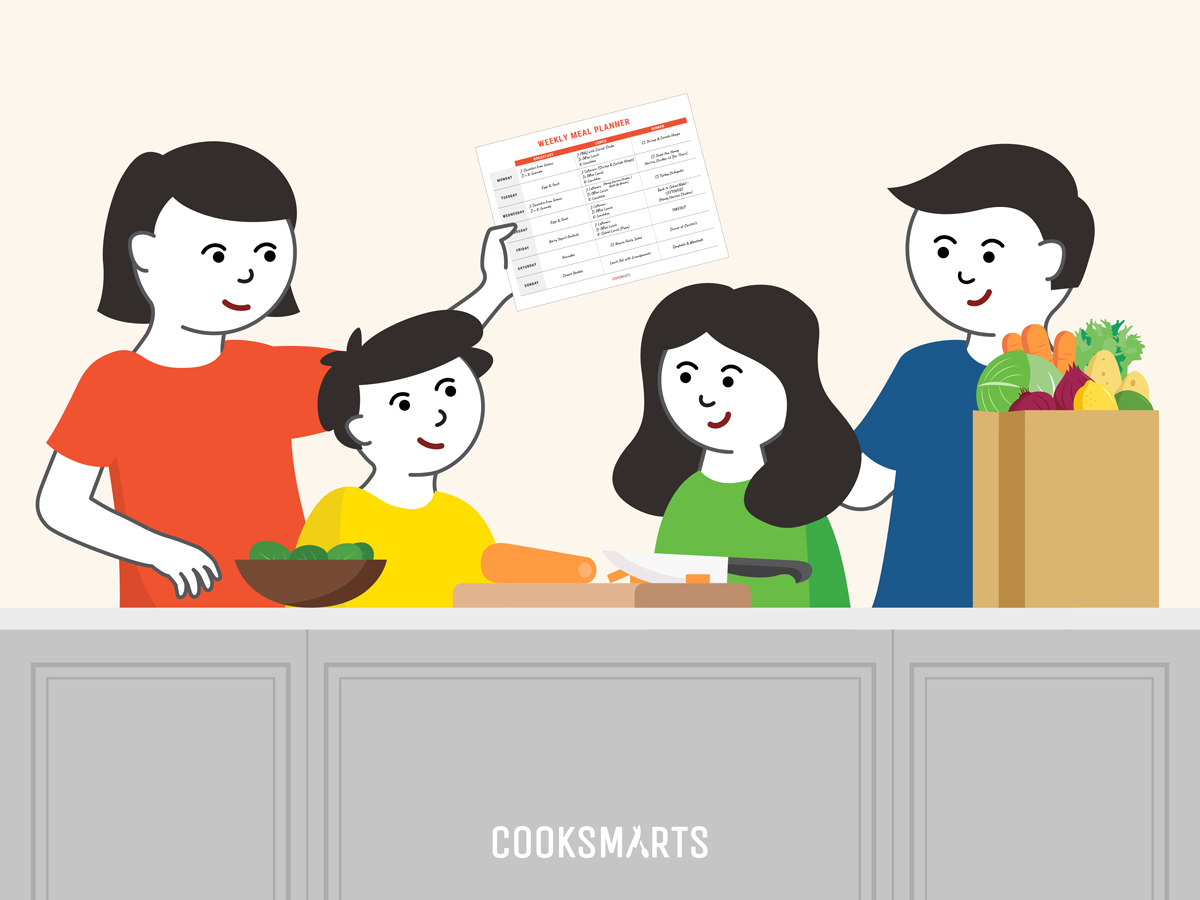
Meet Joanna
In our example, we’re going to meal plan for a fictitious woman named Joanna. Joanna does all the meal planning for her household, which includes her, her husband Darren, and their two kids. Joanna and her husband both work full-time and the kids are in school, which she’ll need to take into account in her planning. She meal plans and grocery shops on Sunday for the week of Monday through the following Sunday.
Today is Sunday, so let’s get started!
Step 1: Add what you know
Joanna’s family always gets takeout on Friday nights, so we’ll go ahead and write that into our meal plan. She also knows that the family goes out to lunch with Joanna’s parents every Sunday. Easy so far!
Joanna goes to the gym on Monday and Wednesday mornings and grabs a smoothie afterward on the way to work, so she’ll only need to plan breakfasts those days for the others in the household. To keep things simple and prepless, we’ll decide now that they’ll have granola for breakfast those two days. We’ll make this distinction in our meal plan by labeling Joanna’s meals with a J, Darren’s with a D, and the kids’ with a K.
Darren buys lunch at work, while Joanna prefers to bring lunch from home — usually leftovers from the night before. The kids bring a lunchbox to school, except on Fridays (pizza day!), when they buy lunch at school. Joanna’s not going to plan exactly what to put in the kids’ lunchboxes each day because she follows a school lunch formula to keep things easy — but she will need to remember to add lunchbox ingredients to her grocery list.
We’ll schedule all that in, and so far Joanna’s meal plan looks like this:
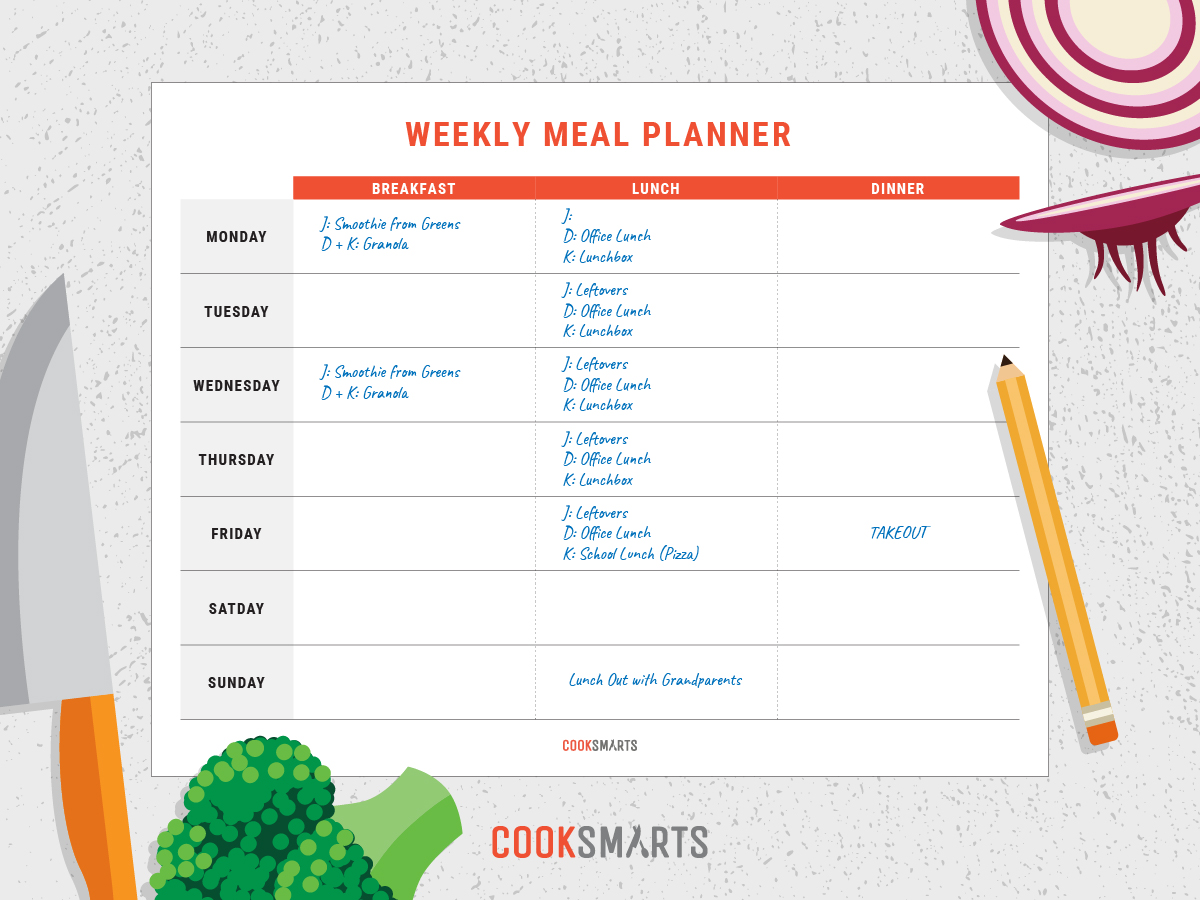
Step 2: Consult the calendar
We’ve added in recurring weekly meals as well as events that will affect meals; now it’s time to account for this week specifically.
Joanna looks at her calendar and sees that the family is going to Back to School Night on Thursday, so there won’t be time to cook dinner. We’ll schedule leftovers for Thursday night, and plan to double a meal earlier in the week. She also sees that they’re scheduled to have dinner at Darren’s sister Christie’s house on Saturday, so she won’t need to plan anything for Saturday night.
That’s all that’s on the calendar for this week, so now Joanna’s meal plan looks like this:
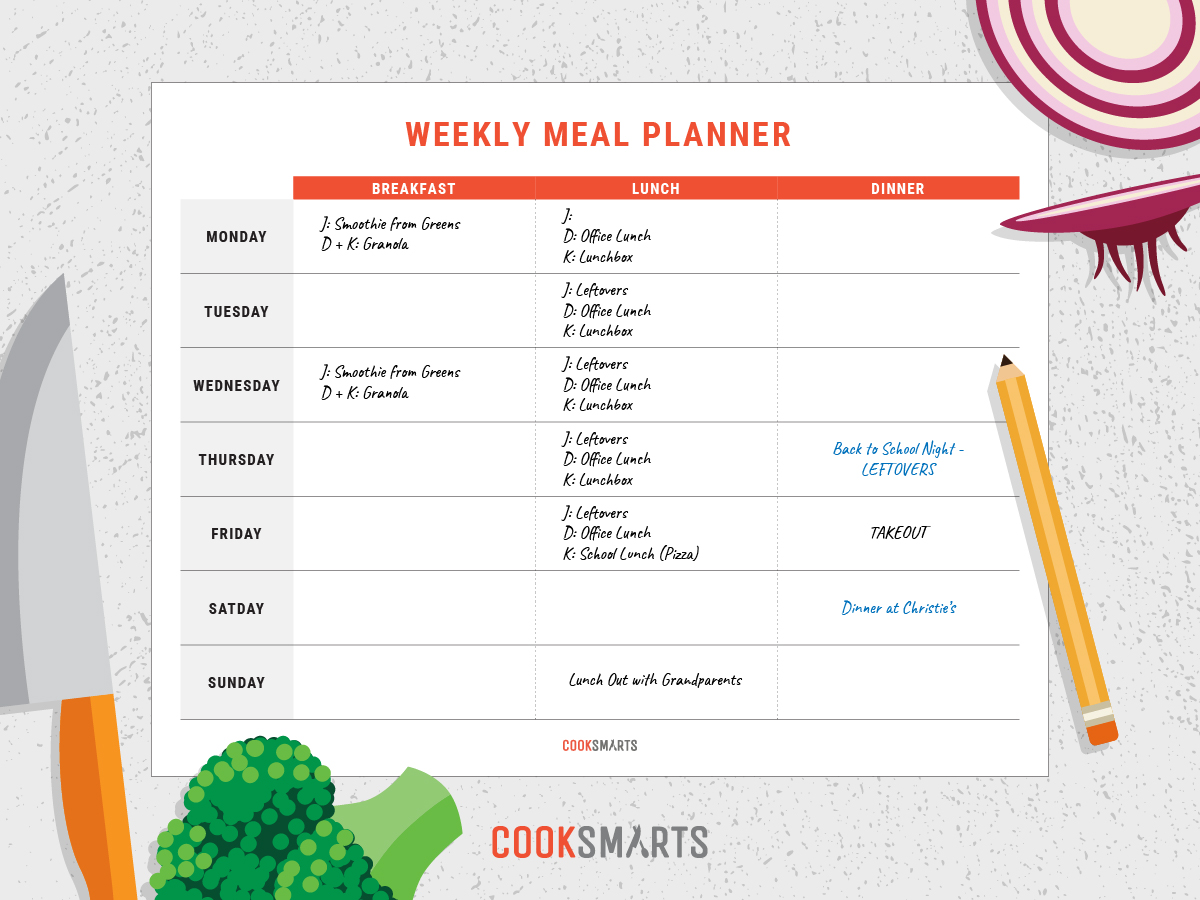
Step 3: Fill in meals
From here, Joanna will choose meals she’d like to cook this week. Our favorite way to do this is to start by making a list of everything that needs to be used from the fridge, and potentially the freezer and pantry as well. In Joanna’s case, she doesn’t have a lot of leftover produce because she’s followed her meal plan well this past week.
Joanna could choose recipes from websites, cookbooks, apps, or old favorites she knows by heart. In her case, though, we’re going to say she’s a Cook Smarts member, so she’ll follow the weekly meal plan she gets through her membership. This week, that includes Shrimp and Curtido Hoagies, Sheet Pan Honey Harissa Chicken, Turkey Chilaquiles, and Nicoise Pasta Salad. She’ll schedule those in on the suggested days, except that the family will have the Nicoise Pasta Salad for lunch on Saturday instead of dinner on Thursday due to Back to School Night. She needs to double a meal to have leftovers for Thursday’s dinner, and chooses the Sheet Pan Honey Harissa Chicken, which she’ll note in her meal plan as well.
In order to have lunch leftovers, Joanna could plan to cook an extra portion for dinner each night, but in this case we’re going to assume the kids are too young to be big eaters, so making 4 portions will yield leftovers already. We’ll also say that for Friday’s lunch, she’ll eat any remaining leftovers from the week — but just in case there aren’t any, we’ll also give her a back-up, or “insurance meal,” of instant ramen. She can add some extras to the soup to make the ramen a complete meal. We’ll give her the same backup on Wednesday as well, just in case there aren’t leftovers one day earlier in the week and lunches need to be shuffled around.
Joanna decides the family will have an easy dinner of Spaghetti and Meatballs (a dish she can make from memory) on Sunday night. There’s also a new pancake recipe a friend sent her that she’s been wanting to try, so she’ll schedule pancakes for breakfast on Saturday.
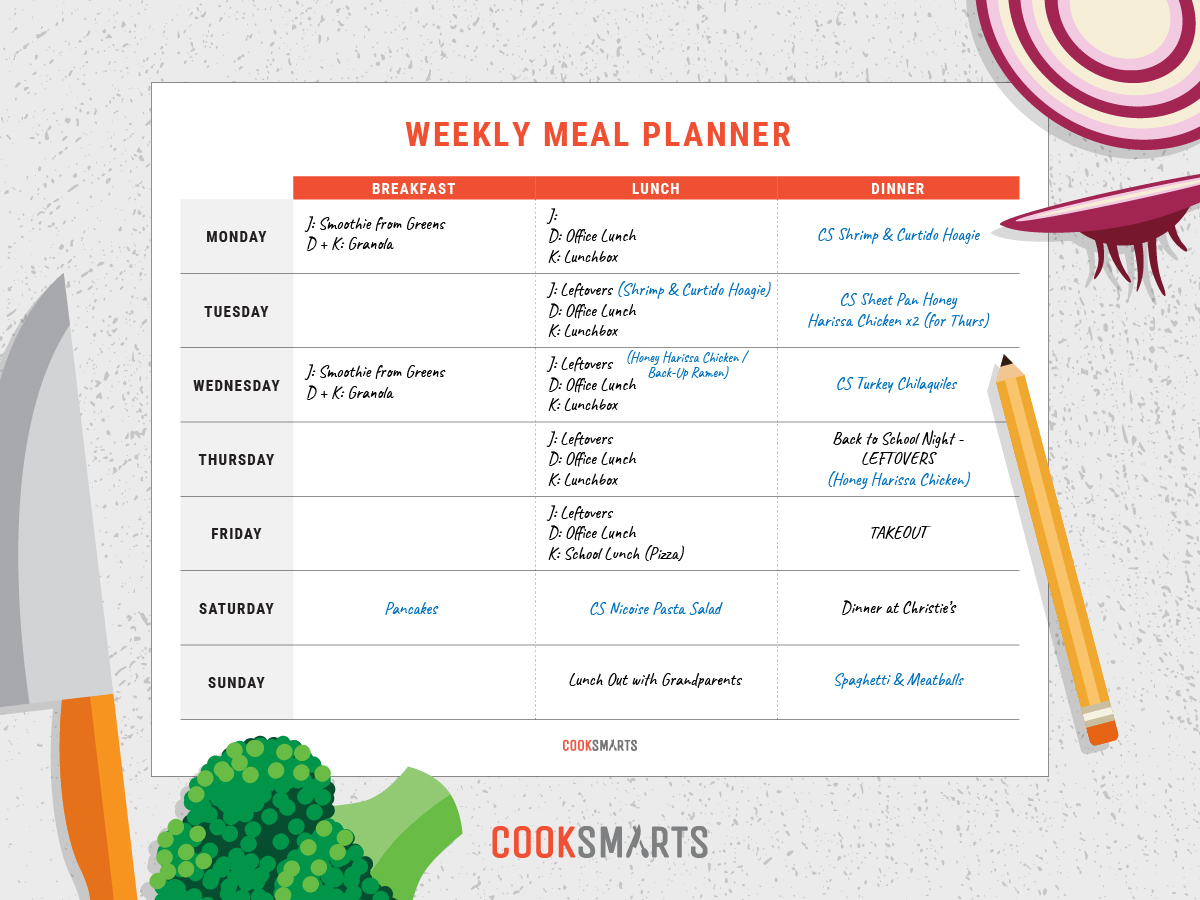
Step 4: Fill in the gaps
Joanna isn’t following specific recipes for breakfasts other than Saturday’s pancakes, so she still needs to fill in most of the family’s breakfasts. She’ll choose some quick and easy meals for the weekdays — eggs and toast on Tuesday and Thursday, and yogurt parfaits on Friday. On Sunday, when she’ll have a little more time to chop veggies in the morning, she’ll plan for omelets.
That just leaves her lunch on Monday, when she won’t have leftovers to bring. She’ll keep things easy with a PB&J and a side of carrot sticks. If she had them, this would also be a good opportunity to use up produce, leftover cooked veggies, and leftover proteins from the previous week.
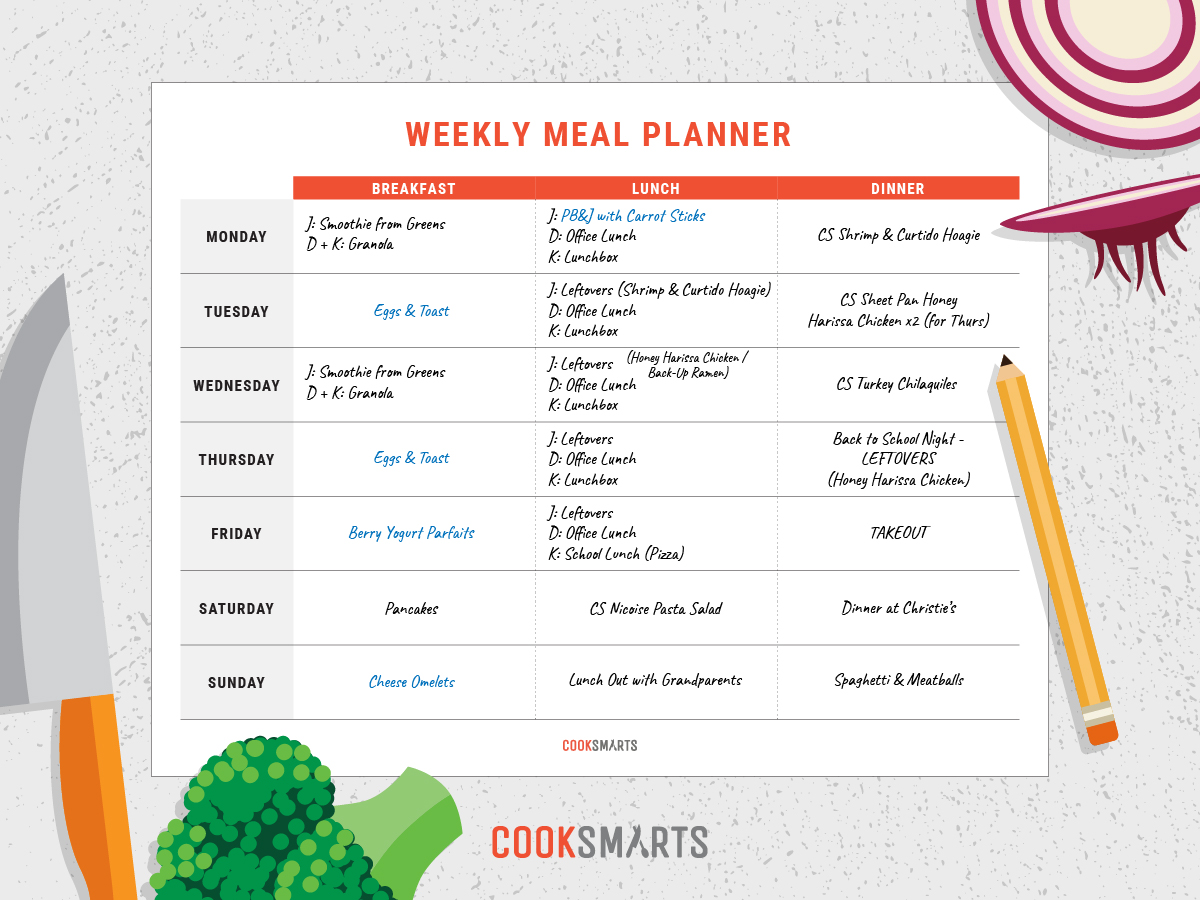
Step 5: Make your grocery list
Now all of Joanna’s family’s meals are planned! All she has left to do is create a grocery list based on what they’ll eat this week. This involves a single click for the Cook Smarts meals, plus she’ll need to manually add ingredients for the other meals to her grocery list.
Additional meal planning considerations . . .
Follow these tips to make sure your meal plan can be carried out smoothly:
1. Schedule meals in order of their ingredients’ shelf life
Fresh seafood should be eaten the day you buy it or the next day. Delicate produce like lettuce and spinach need to be eaten within a few days, so are best used early in the week. And of course, if you already have veggies in your fridge from the previous week (and they’re still in good shape), prioritize them in your meal plan. Check out our Produce Shelf Life infographic for more:
Reduce Food Waste with Our Produce Shelf Life Guide
With our vegetable shelf life guide, you can waste less food which will save money. Try out this one waste… Read more.
If it makes it easier, you can make a note in your meal plan to choose a meal for Monday that uses the specific leftover produce you have, so that you can be sure it gets used. If you’re using a service like Cook Smarts meal plans, it’s easy to search the recipe archives by ingredients to find a meal that fits the ingredients you have on hand.
2. Break each meal down
If it’s helpful for your meal planning style and dietary preferences, you may want to break your meals down in your plan by listing “produce,” “protein,” and “carbohydrate” for each meal, and filling in foods for each component. That way, you can easily see where you have gaps, and won’t end up with nothing but a side salad planned for dinner one day.
3. Choose some efficiencies
Use your time wisely by choosing some “prep once, eat twice” foods. Exactly how you do this is up to you. Some people like to eat leftovers of each meal, so you might cook Monday and Tuesday, then eat Monday’s leftovers on Wednesday and Tuesday’s leftovers on Thursday. Or maybe you double your meals to have easy lunches the next day, similar to Joanna’s approach in our example. Still another option is to cook a portion of a meal, and then turn the leftovers into a new meal entirely, like what we do with these Cook Once, Eat Twice recipes:
Save Hours Each Week With These Cook Once, Eat Twice Recipes
Repurposed recipes make cooking easy and quick. Our free mini recipe book has 5 tasty recipes that can be transformed… Read more.
Other people double only their grains, vinaigrettes, or marinades to have a head start on meals later in the week without eating the exact same meal twice. And others will roast a large amount of veggies on Monday and use leftovers for tacos, soups, sandwiches, or salads throughout the week. Choose what works for you.
4. Include prep in your schedule
Need to marinate chicken overnight on Wednesday to have it for dinner Thursday night? Make a note in your meal plan or on your daily calendar to complete that step on Wednesday. This will prevent you from having unpleasant surprises during the week, and reduce the chance you’ll need to rely on insurance meals.
Printable meal planning template
We know this all seems like a lot, but once you get started, you’ll be able to get the hang of it! Just remember to tweak things as you go to make meal planning work for you and your family. To make meal planning easy, print out our blank meal planning template calendar (like the one Joanna uses!) to create your own meal plan for the week. Fill in breakfasts, lunches, and dinners for each day so you always know what’s coming up. No email sign-up required!
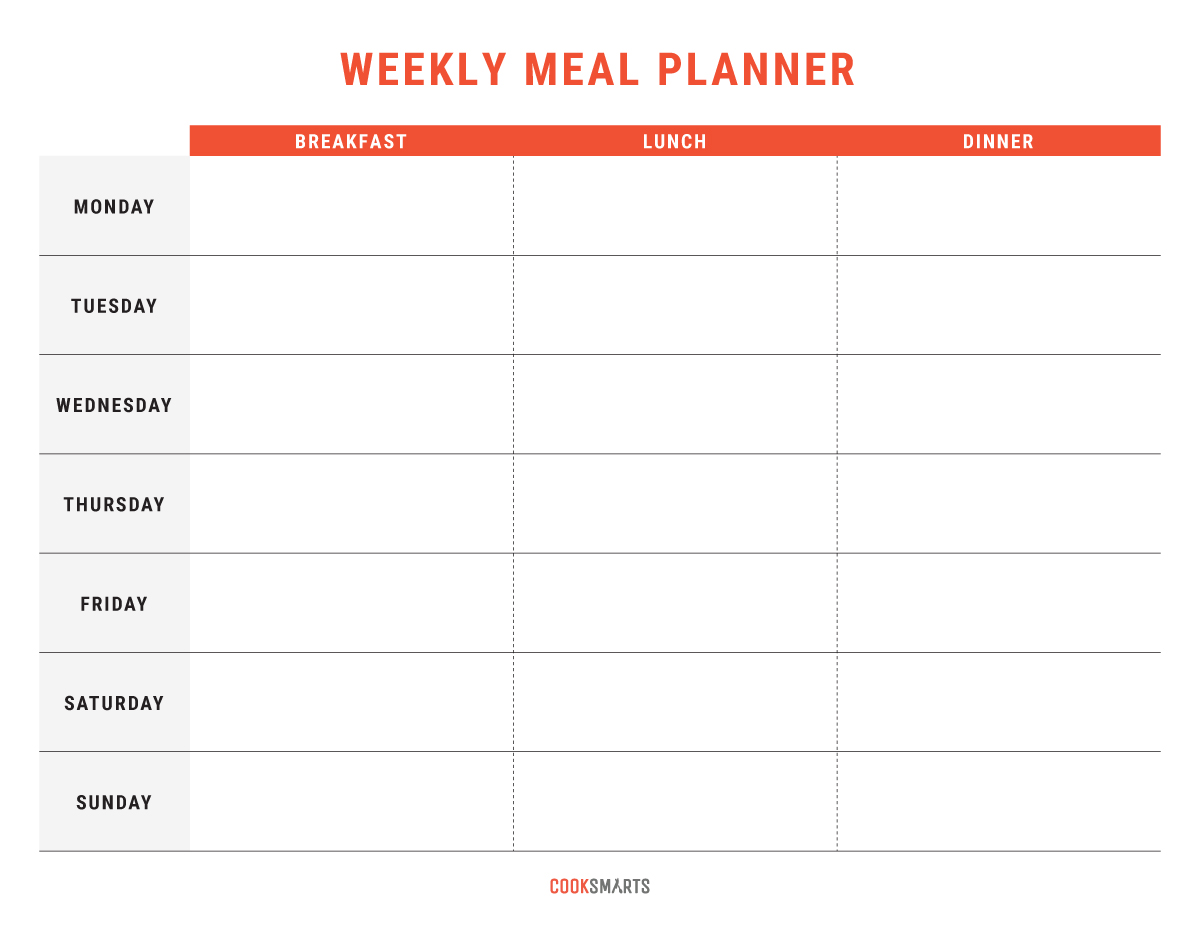
To simplify the process of meal planning and let someone else do much of the work for you, sign up for a free 14-day trial of our meal plan service. You’ll get full access to weekly dinner meals plans, thousands of additional recipes from the archives that can be added or swapped, a one-click grocery list, and full optional Instacart integration!
